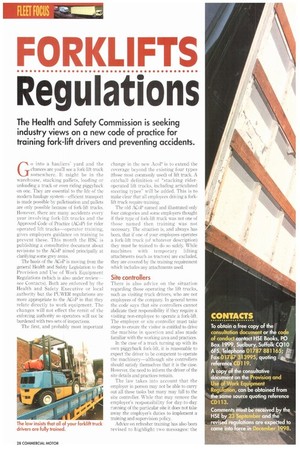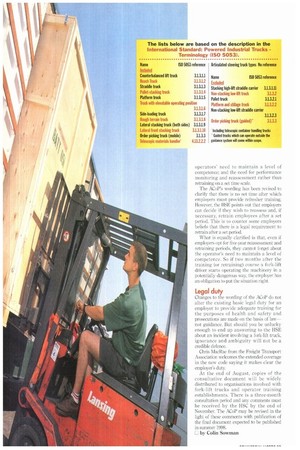FORKLIFTS
Page 30

Page 31

If you've noticed an error in this article please click here to report it so we can fix it.
Regulations
The Health and Safety Commission is seeking industry views on a new code of practice for training fork-lift drivers and preventing accidents.
Go into a hauliers yard and the chances are you'll see a fork-lift truck somewhere. It might he in the warehouse, stacking pallets, loading or unloading a truck or even riding piggyback on one. They are essential to the life of the modern haulage system—efficient transport is made possible by palletisation and pallets are only possible because of fork-lift trucks. However, there are many accidents every year involving fork-lift trucks and the Approved Code of Practice (ACoP) for rider operated lift trucks—operator training, gives employers guidance on training to prevent these. This month the HSC is publishing a consultative document about revisions to the ACoP aimed principally at clarifying some grey areas.
The basis of the ACoP is moving from the general Health and Safety Legislation to the Provision and Use of Work Equipment Regulations (which is also under review— see Contacts). Both are enforced by the Health and Safety Executive or local authority but the FIVER regulations are more appropriate to the ACoP in that they relate directly to work equipment. The changes will not effect the remit of the enforcing authority so operators will not be burdened with two sets of inspections.
The first, and probably most important change in the new AcoP is to extend the coverage beyond the existing four types (those most commonly used) of lift truck. A catchall definition of "stacking rideroperated lift trucks, including articulated steering types" will be added. This is to make clear that all employees driving a forklift truck require training.
The old ACoP named and illustrated only four categories and some employers thought if their type of fork-lift truck was not one of those named then training was not necessary. The situation is, and always has been, that if one of your employees operates a fork-lift truck (of whatever description) they must he trained to do so safely. While machines with temporary lifting attachments (such as tractors) are excluded, they are covered by the training requirement which includes any attachments used.
Site controllers
There is also advice on the situation regarding those operating the lift trucks. such as visiting truck drivers, who are not employees of the company In general terms the code says that site controllers cannot abdicate their responsibility if they require a visiting non-employee to operate a fork-lift. The employer or site controller must take steps to ensure the visitor is entitled to drive the machine in question and also made familiar with the working area and practices.
In the case of a truck turning up with its own piggyback fork-lift, it is reasonable to expect the driver to be competent to operate the machinery—although site controllers should satisfy themselves that it is the case. However, the need to inform the driver of the site details and practices remain.
The law takes into account that the employer in person may not be able to carry out all these tasks hut many may fall to the Site controller. While that may remove the employer's responsibility for day-to-day running of the particular site it does not take away the employer's duties to implement a training and supervision policy Advice on refresher training has also been revised to highlight two messages: the operators' need to maintain a level of competence; and the need for performance monitoring and reassessment rather than retraining on a set time scale.
The ACA's wording has been revised to clarify that there is no set time after which employers must provide refresher training. However, the HST4'. points out that employers can decide if they wish to reassess and, if necessary, retrain employees after a set period. This is to counter some employers beliefs that there is a legal requirement to retrain after a set period.
What is equally clarified is that, even if employers opt for five-year reassessment and retraining periods, they cannot forget about the operator's need to maintain a level of competence. So if two months after the training (or retraining) course a fork-lift driver starts operating the machinery in a potentially dangerous way, the employer has an obligation to put the situation right.
Legal duty
Changes to the wording of the ACoP do not alter the existing basic legal duty for an employer to provide adequate training for the purposes of health and .safety and prosecutions are made on the basis of law-not guidance. But should you be unlucky enough to end up answering to the HSE about an incident involving a fork-lift truck, ignorance and ambiguity will not be a credible defence.
Chris MacRae from the Freight Transport Association welcomes the extended coverage in the new code saying it makes clear the employer's duty.
At the end of August, copies of the consultative document will be widely distributed to organisations involved with fork-lift trucks and operator training establishments. There is a three-month consultation period and any comments must be received by the HSC by the end of November. The ACM) may be revised in the light of these comments with publication of the final document expected to be published in summer 1998.
Li by Colin Sowman
































































































